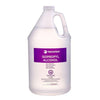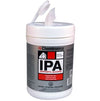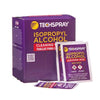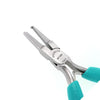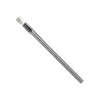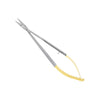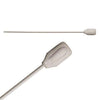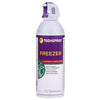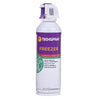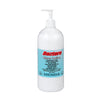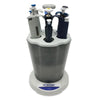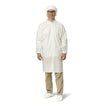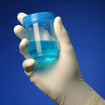- No products in the cart.
Difference Between Nitrile and Latex Gloves: Which Is Better for Your Purposes?
May
20
2021
When choosing which type of gloves to use, it is helpful to know the differences between nitrile and latex gloves.
What is Nitrile?
Nitrile (Acrylonitrile Butadiene Rubber) is manufactured from a 100% inorganic synthetic material. This means the material used to make the glove is completely man-made. This process allows the manufacturing of nitrile gloves to be totally controlled, and free of potential allergens.
What is a Nitrile Glove?
A nitrile glove provides a safe barrier between whatever you may be working with, and your hands. It is an industrial grade, disposable glove that is often used in industries where dexterity is required. Nitrile material provides comfort and dexterity for the wearer, without restricting or impairing too much movement.

Top uses of Nitrile Gloves:
Because of the dexterity allowed by nitrile gloves, and due to their allergen-free composition, they can be worn in many different settings and industries. Most commonly, they are used for cleanroom and laboratory environments. Here are some of the most common settings and industries that utilize nitrile gloves:
- Custodial & Janitorial settings
- Manufacturing industry
- Automotive industry
- Food processing settings
- Handling hazardous or corrosive chemicals
- Medical & laboratory environments
Pros & Cons of Using Nitrile Gloves
When it comes to the use of nitrile, there are many benefits and very few cons. Nitrile gloves are incredibly puncture-resistant, allowing them to provide powerful barrier protection. This decreases the risk of the wearer of experiencing an unexpected and potentially dangerous breach of their personal protective equipment which might expose them to bodily fluids, harsh chemicals, or other contaminants. Nitrile protects well against many chemicals, as well as solvents and acids. If you would like to see if a nitrile glove protects against a certain chemical or acid, a glove chemical compatibility chart can be found here.
Nitrile’s “memory” properties allow the material to adapt to the wearer’s hand, providing greater comfort, dexterity, and reduces fatigue. Nitrile also has properties that dissipate static, which make nitrile gloves a common choice for manufacturing environments. Lastly, nitrile contributes very few particles to a work environment, reducing contamination.
There really are very few negatives to choosing a nitrile glove over latex, other than personal preference. It is important for the glove wearer to be able to move well and perform all of their required actions in a safe manner. You should consider your hand size, intended use and environment, along with comfort when deciding which nitrile gloves to buy.
Lab Pro has a wide variety of nitrile gloves available here.
Latex Gloves: What is Latex?
Latex is the most common material for gloves. It is a biodegradable material made from organic tree saps otherwise known as natural rubber. Latex also contains allergy-causing proteins, meaning many are unable to use latex gloves or receive services from someone wearing a latex glove.
What is a Latex Glove?
A latex glove is a piece of personal protective equipment that provides a safety barrier for the wearer and those the wearer may touch. Latex gloves are the most common gloves and provide a lot of dexterity and comfort for the wearer. It offers effective protection against bodily fluids, pathogens, and some chemicals. Latex gloves can come in various sizes and thicknesses. This provides different levels of durability from tears or punctures. Latex gloves can also be powder-free, lightly powdered, or powdered. This powder (cornstarch) allows the gloves to be more easily put on.
Top Uses of Latex Gloves:
Because latex offers the most strength and durability, while still providing good tactile sensitivity, latex gloves can be used in a variety of settings.
- Medical settings
- Auto repair settings
- Food service environments
While latex gloves are very commonly used in medical settings, those with latex allergies or those who are treating someone with a latex allergy will have to use a different type of glove.
Pros & Cons of Latex Gloves
Latex provides a high level of comfort and dexterity, while being the most durable glove against rips and tears. It also provides protection against alcohols, acids, and ketones. Information on chemical compatibility can be found here. Latex does not protect against as many chemicals as nitrile does, and it is important to know what you will be working with in order to choose the best glove for you.
Latex is also a known allergen, meaning that those with allergies cannot wear latex gloves nor receive medical services from someone wearing latex gloves.
Depending on your purposes, latex gloves can provide an excellent level of protection while still allowing for optimal dexterity and comfort. Lab Pro has a wide variety of latex gloves available here.
In Summary:
When choosing between latex and nitrile, knowing your intended purposes and environment is of the utmost importance to make sure that you are protected, comfortable, and able to work safely and effectively.
For over 40 years, Lab Pro Inc. has been committed to delivering the highest quality cleanroom gloves, distance learning kits, lab supplies, chemicals, and cleanroom PPE apparel to teaching institutions and laboratories worldwide. To learn more, visit the biggest Lab Supply showroom in California, or contact us online or at 888-452-2776.







